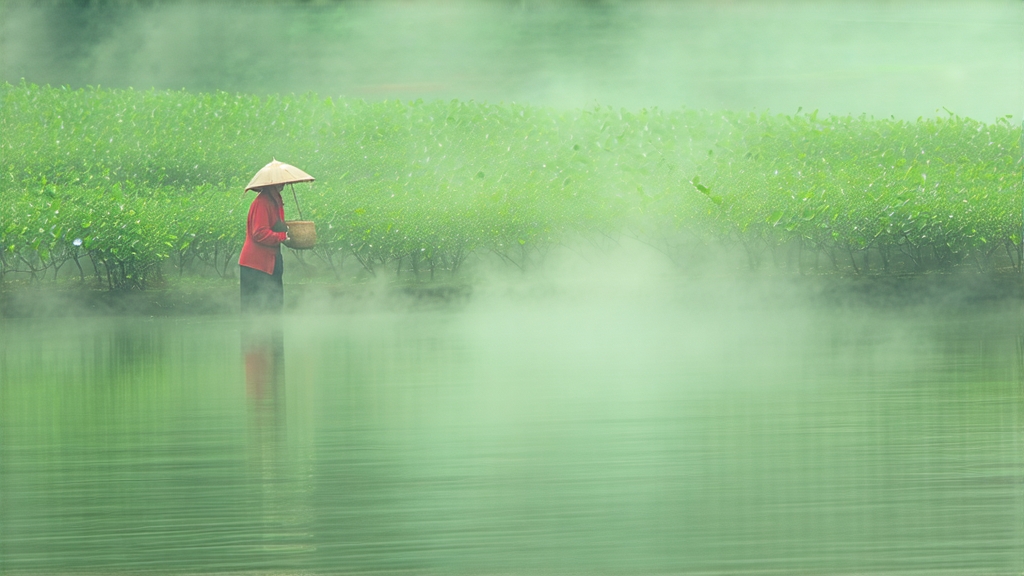
Biluochun, whose name literally means “Green Snail Spring,” is one of China’s ten most celebrated teas, yet it remains a quiet treasure beyond the country’s borders. Grown in the mist-cradled hills that rim eastern Taihu Lake in Jiangsu Province, this tiny, spiral-shaped green tea carries within its curled leaves five centuries of imperial praise, maritime trade lore, and meticulous hand-craft. To understand Biluochun is to listen to a soft, fragrant echo of southern China’s springtime, captured in a single sip.
Historical whispers place Biluochun’s birth during the late Ming dynasty. Local chronicles tell of tea pickers who, while gathering wild leaves in the Dongting mountains, found their baskets perfumed by the surrounding peach, plum, and apricot blossoms. The tea absorbed the orchard aromas so naturally that when the dried leaf reached the imperial court in Beijing, the Kangxi Emperor (r. 1661-1722) declared its fragrance “astonishingly fresh,” renamed it from the rustic “Xia Sha Ren Xiang” (“Scary Fragrance”) to the elegant “Biluochun,” and listed it as an annual tribute. European tea merchants first recorded the name in 1810 in the Canton custom logs, describing “small snail-form tea, pale liquor, flowery nose,” proof that even then the leaf’s tight spiral and penetrating aroma were unmistakable.
Strictly speaking, only leaf plucked within the narrow micro-basin of Dongting Dongshan and Xishan peninsulas can claim the protected designation “Original Biluochun.” Here, the lake acts as a vast heat reservoir, creating nightly mists that slow photosynthesis, coax the plant into producing more amino acids, and veil the bushes in soft, diffused light. Granite-rich soils, moderate winters, and the constant interplay of humidity and breeze give the tea its hallmark sweetness and low astringency. Outside this core zone, similar cultivars are grown in Sichuan, Guizhou, and Zhejiang, yet connoisseurs note that only Taihu’s terroir delivers the subtle “watery sweetness” (shui yun) that lingers at the back of the throat.
The cultivar itself is a diminutive-leaf Camellia sinensis var. sinensis locally called “Xiao Ye Zhong.” Its modest leaf area concentrates flavor, while an unusually high ratio of cis-3-hexenol to geraniol provides the signature fruity-floral top note. Farmers keep the bushes waist-high to encourage lateral budding and ease hand plucking. Every March, when night temperatures hover around 10 °C and the first green apical leaf unfurls to the size of a sparrow’s tongue, plucking begins. The standard is one bud plus the immediate unfolding leaf, about 15 mm in length, yielding roughly 110,000 such shoots to make one kilogram of finished tea.
Crafting Biluochun is a race between oxidation and the artisan’s wrist. Within minutes of plucking, the fragile shoots are spread in bamboo trays no thicker than two centimeters and withered for three to four hours in shaded draft. The goal is not desiccation but a gentle loss of grassy edge while preserving the raw leaf’s succulence. Next comes the most iconic step: spiral shaping in a hot, bare wok held at 80 °C. Using only the pressure of fingertips and the heel of the palm, the tea master rolls the leaf in alternating clockwise and counter-clockwise motions. Moisture evaporates, cell walls rupture, and the leaf slowly curls into a tight spiral resembling a tiny snail shell. The temperature is then dropped to 60 °C for the final drying phase, locking in the jade-green color and stopping enzymatic activity within 40 minutes. When finished, each gram contains roughly 120 individual spirals, silver-tipped and downy.
Because the leaf is so young and delicate, water that is even slightly too hot can cook the amino acids into bitterness. The classic Jiangsu gaiwan service calls for 75 °C spring water, 3 g of leaf, and a 150 ml vessel. After pre-warming, the leaf is introduced, the lid briefly rotated to awaken the aroma, and water is poured along the cup’s edge to avoid scalding the bud. The first infusion, 30 seconds, releases a pale celadon liquor with a rising perfume of pear, nasturtium, and fresh soy milk. The second infusion, 15 seconds, is often considered the most balanced, where umami, floral lift, and a faint mineral